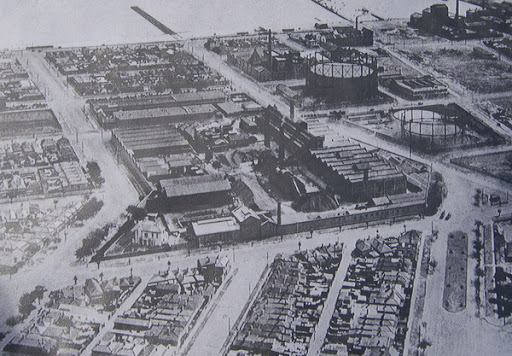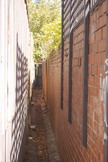Take a time travel journey down suburban lanes in the footsteps of dunnymen, ice-men, bottle-o, milkmen, grocers, garbos and coal carts. Discover bluestone stables, old dairies, chimneys, gas worker cottages and the great Australian outhouse.
The map below shows the location of the walk and some places of interest marked by the blue place holders. Click on a place holder to view a photo of the site.
View Larger Map
We started at the park, where our guide Meyer Eidelson introduced himself. In the streets around the park stand majestic mansions that were build by very wealthy people. One of the mansions belonged to the Guests of Guests Biscuits fame. The park was originally fenced with only the well off having a key to the gate. The poor people who lived near by were excluded.
In the late 19th Century the city was very unhealthy. This was clearly the case for the poorer classes but ill health caused by poor sanitation also effected the wealthy. The Guest family, for instance, had 8 children, but only three of them lived to adulthood. Some people earned a living taking away the "night soil". These men would usually work at night taking the full cans of waste and replacing them with "fresh" ones. If the toilet was not accessible from the fence line they would enter properties to fetch the cans. They would often blow a whistle or sing to alert any occupant of their arrival.
Irrespective of the labor of the night soil men, a great deal of waste seeped into the city's ground water and water supplies. This was a major cause of the ill health of 19th Century Melbourne. It became obvious in the late 19th Century that the city had to be sewered as a matter of urgency. The Melbourne and Metropolitan Board of Works was constituted by an Act of Parliament in 1890 and began operations in July 1891, but the process of sewering did not begin until 1897 when the Spotswood Pumping Station was completed. Most services at the time were private and commercial, but the risk to public health was so palpable that connection to the new sewer system was compulsory.
The rich and poor lived cheek by jowl. If you click on the place marks on the Google Map you will notice that houses built for working people are just a block away from the mansions around the park. The small houses were occupied by large families, which meant that much of the socializing and entertainment was carried on in the streets. Consequently community was much more important than today. In many suburbs today we stay behind our locked doors for security reasons. Ironically, in earlier times the community provided security as there were always people mingling in the streets. Interestingly,a according to Meyer, this tradition continues in the, now gentrified, Albert Park area, at least partly because of the small size of the houses.
Many of the working people found jobs at the South Melbourne Gas Works, not far away on the other side of Richardson Street. Part of the site is now occupied by the Gasworks Arts Park. Formed in 1872, the Gasworks began supplying gas in 1873. It operated 24 hours a day and employed several hundred men. Black coal was hauled from the town pier at the end of Bay Street, Port Melbourne by horse drawn tram. The working conditions were harsh, strenuous and dirty. The heat could be felt outside the fence surrounding the works. Workers wore wooden clogs to insulate their feet from the heat of the floors. As well a layer of coal dust quickly covered all surfaces in the gasworks and in surrounding streets.
The aerial photograph of the gasworks, below, was one of the many documents that Meyer displayed during the walk. Notice, in particular, the gasholder at the top right of the photo. It could also be a dangerous place to work. In 1920 one of the gasholders exploded without warning. There are stories of people praying in the streets because they thought that it was the end of the world. One eyewitness reported:
I was 12 or 14, playing alleys with me mates on the corner…there was a big rumble, a great big fireball, heat scorched us; ran home to mother, scared out of our wits, to see if she was all right."

The explosion was so loud that it was heard from Rosebud to Hurstbridge. Surprisingly no one was killed in the explosion.
Another famous event at the gasworks was the 1937 stay-in-strike, the first of its kind in Australia. The workers entertained themselves with dances, including clog dances.
The women stayed home while their menfolk were off working, though to augment the family income women often ran small businesses from their front doors and windows. One example that we saw was a dairy. The barn which has been converted into a modern garage, could clearly be seen. Obviously the cow was "pastured" in the small back yard. A photograph of the dairy can be seen by clicking on the place holder in Little Glover Street, on the map. Meyer showed us documents that indicated that there were many small dairies in the area. As well it was obvious that many of them were unsanitary, causing some of the ill-health of the community.
Meyer gave us an interesting and informative tour of a small part of Albert Park, which I would recommend to anyone interested in Melbourne's heritage.

No comments:
Post a Comment